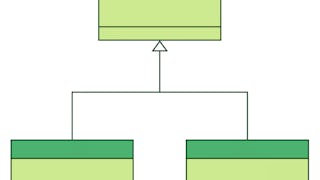An applied analysis and design class that addresses the use of object-oriented techniques. Topics include domain modeling, use cases, architectural design and modeling notations. Students apply techniques in analysis and design projects. Focus is on key object-oriented design patterns and principles.



Object-Oriented Analysis and Design: Patterns and Principles

Dozent: Bruce Montgomery, PhD, PMP
Bei  enthalten
enthalten
Empfohlene Erfahrung
Was Sie lernen werden
Recognize design challenges in creating maintainable object-oriented systems
Apply appropriate standard design patterns to solve typical object-oriented design issues
Understand the principles behind the patterns applied to solve object-oriented development problems
Wichtige Details

Zu Ihrem LinkedIn-Profil hinzufügen
Dezember 2024
4 Aufgaben
Erfahren Sie, wie Mitarbeiter führender Unternehmen gefragte Kompetenzen erwerben.


Erwerben Sie ein Karrierezertifikat.
Fügen Sie diese Qualifikation zur Ihrem LinkedIn-Profil oder Ihrem Lebenslauf hinzu.
Teilen Sie es in den sozialen Medien und in Ihrer Leistungsbeurteilung.

In diesem Kurs gibt es 5 Module
Continuing examinations of the benefits and challenges of applying design patterns and related principles in Object-Oriented Analysis and Design (OOAD). The overall specialization and the instructor are introduced here. Topic lectures introduce the origins and intent behind Object-Oriented (OO) pattern definitions, and then examine two common OO patterns - Strategy and Observer - for their purpose, structure, supporting principles, and typical applications in the design and development of OO applications. Students should have some background in OO foundational elements, Java, JUnit, and UML (all covered in the prior OOAD foundations & concepts course). These topics are prerequisites to gaining the most benefit from lectures and performing design and development assignments, so students may want to consider appropriate tutorial study as needed.
Das ist alles enthalten
8 Videos5 Lektüren1 Aufgabe1 peer review2 Diskussionsthemen1 Unbewertetes Labor
This module focuses on structural OO patterns - patterns that help with object composition or making complex designs more efficient and flexible. Included here are discussions of Decorator, Facade, Adapter, Proxy, Composite, Flyweight, and Bridge. Supporting OO principles will also be discussed, as well as design topics such as multiple inheritance use guidelines and tradeoffs between the principles and implementation approaches. The project assignment (using Decorator for this module) will be the first design and development effort for an application that will be extended and refactored in each follow-on module.
Das ist alles enthalten
7 Videos1 Lektüre1 Aufgabe1 Programmieraufgabe1 peer review
We continue the examination and assessment of OO design patterns by looking at creational patterns here. Creational patterns provide alternative approaches for creating and instantiating objects, strengthening designs by separating the logic for object creation from object use. Supporting principles (e.g. Dependency Inversion), concepts (deep and shallow copies), and example applications will be provided. OO patterns reviewed here include Factory, Abstract Factory, Singleton, Object Pool, Prototype, and Builder. The project assignment (using Abstract Factory for this module) will be another step in extending and refactoring the class-long application design and development effort.
Das ist alles enthalten
6 Videos1 Lektüre1 Aufgabe1 Programmieraufgabe1 peer review
The final full module of OO design pattern reviews focuses on the behavioral OO patterns, the largest category of patterns that help provide structure for object interactions and responsibilities. The lectures look in detail at Command, State, and Template patterns, with a somewhat briefer review of Iterator, Mediator, Memento, Interpreter, Chain of Responsibility, and Visitor. Supporting principles, pattern structures, and examples of use and implementation are also reviewed. The project assignment continues the build of the class-long application design and development effort, adding the Command pattern to support additional functionality.
Das ist alles enthalten
6 Videos1 Lektüre1 Aufgabe1 Programmieraufgabe1 peer review
In this last class module, we take a look at building patterns from other patterns - creating compound patterns - by examining the most commonly encountered compound pattern, Model/View/Controller (MVC). We also look at a development approach called Thinking in Patterns that encourages pattern use in the analysis and design process. (Both MVC and Thinking in Patterns will be revisited in the final OOAD course.) The capstone project provided here is the last step in the class-long design and development effort, integrating State, Singleton, and Observer patterns for extending and finalizing the application functionality.
Das ist alles enthalten
5 Videos1 Lektüre1 Programmieraufgabe1 peer review
Dozent

Empfohlen, wenn Sie sich für Software Development interessieren

University of Colorado Boulder

University of Colorado Boulder

University of Alberta

LearnQuest
Auf einen Abschluss hinarbeiten
Warum entscheiden sich Menschen für Coursera für ihre Karriere?





Neue Karrieremöglichkeiten mit Coursera Plus
Unbegrenzter Zugang zu 10,000+ Weltklasse-Kursen, praktischen Projekten und berufsqualifizierenden Zertifikatsprogrammen - alles in Ihrem Abonnement enthalten
Bringen Sie Ihre Karriere mit einem Online-Abschluss voran.
Erwerben Sie einen Abschluss von erstklassigen Universitäten – 100 % online
Schließen Sie sich mehr als 3.400 Unternehmen in aller Welt an, die sich für Coursera for Business entschieden haben.
Schulen Sie Ihre Mitarbeiter*innen, um sich in der digitalen Wirtschaft zu behaupten.
Häufig gestellte Fragen
Access to lectures and assignments depends on your type of enrollment. If you take a course in audit mode, you will be able to see most course materials for free. To access graded assignments and to earn a Certificate, you will need to purchase the Certificate experience, during or after your audit. If you don't see the audit option:
The course may not offer an audit option. You can try a Free Trial instead, or apply for Financial Aid.
The course may offer 'Full Course, No Certificate' instead. This option lets you see all course materials, submit required assessments, and get a final grade. This also means that you will not be able to purchase a Certificate experience.
When you purchase a Certificate you get access to all course materials, including graded assignments. Upon completing the course, your electronic Certificate will be added to your Accomplishments page - from there, you can print your Certificate or add it to your LinkedIn profile. If you only want to read and view the course content, you can audit the course for free.
You will be eligible for a full refund until two weeks after your payment date, or (for courses that have just launched) until two weeks after the first session of the course begins, whichever is later. You cannot receive a refund once you’ve earned a Course Certificate, even if you complete the course within the two-week refund period. See our full refund policy.
Weitere Fragen
Finanzielle Unterstützung verfügbar,

